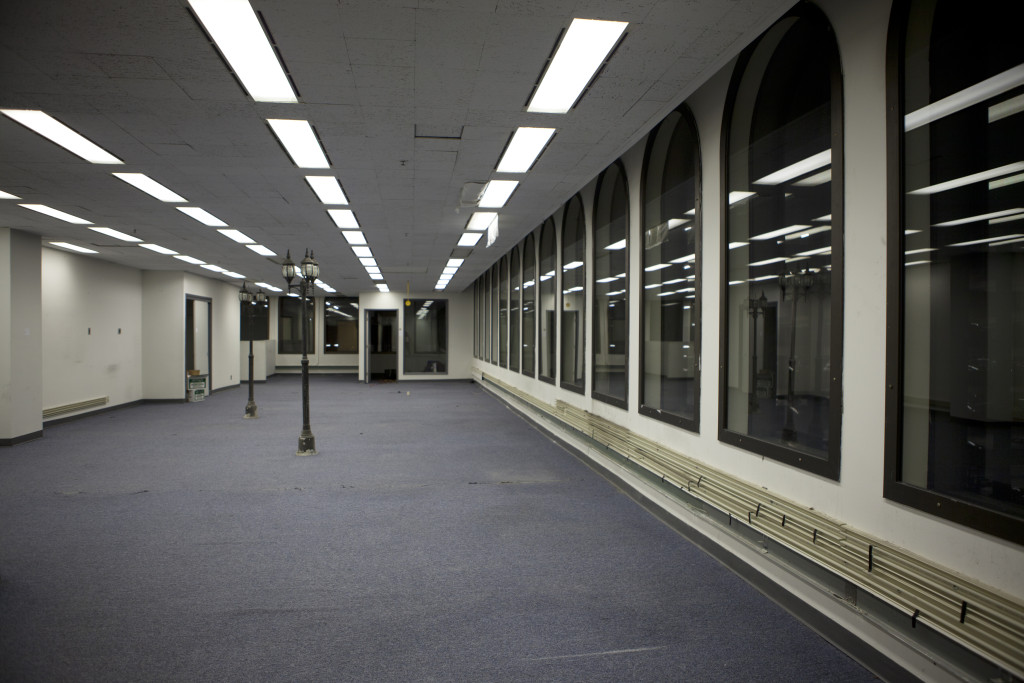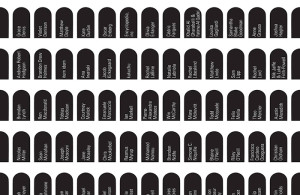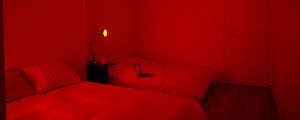Protected under Los Angeles’ historical preservation codes, 9800 S Sepulveda Blvd lies as a vacant testament to 1960s Los Angeles, one where the junction of freeways, air travel and mass mechanization correlated with greater personal and economic mobility. The nine-story building was designed by Welton Beckett, the architect responsible for the Capitol Records and Theme buildings, as part of a larger development skirting the LAX airport. It is this backdrop of surplus modernism that provides the setting for the 9800 group exhibition, occupying eight floors of the empty building with more than one hundred artists’ works, performances and site-specific installations including Rachel Lord, Zoe Crosher, Khalid Al Gharabali + Fatima Al Qadiri, Sam Lipp and many more.
As part of the show, nearly every floor is taken over by a certain curator or organization. Three spaces are particularly noteworthy, starting with J. Shyan Rahimi’s curated lobby and basement titled If I Did It that alludes to varying displays of concealment, deception and entrapment echoing the title of O.J. Simpson’s memoir. This narrative is loosely drawn on the ground floor with a text-based piece ‘Burning Questions?’ (2015) by Tracy Jeanne Rosenthal mounted on multiple acrylic panels describing her descent into a web-based pop-up subscription service. Above her work hang video pieces by Simone Niquille depicting distorted, digital masks of Britney Spears and other pop icons. Further on, an installation by Sean Raspet vaporizes synthetic sugar that, when inhaled, creates a sensation of sweetness deep in the throat.

In the basement, the scale of the work grows more ambitious. A videogame by Ryan Trecartin and Lizzie Fitch’s Witness 360 + Fitch + Trecartin Studio allows you to fly as a drone around a Masonic Temple and, in another room, Doug Rickard’s selection of banned Youtube videos depict an underbelly of illicit behavior across the globe. Yet perhaps the best illumination of the relationship between concealment and malfeasance is a room occupied by an installation by Encyclopedia Inc. featuring an overlapping audio soundtrack of Arabic and English. These recordings were ostensibly used to justify the evidence of Iraq’s acquisition of uranium concentrate ‘Yellowcake’ in the lead-up to the United States’ 2003 invasion of Iraq. For a selection of work rooted in the concept of questionable motives, it is the best demonstration of an illicit intent lost within the process of the dissemination of meaning.
On the fourth floor, is a selection of much more modest works curated by Parisians Pierre-Alexandre Mateos and Charles Teyssou. As opposed to the other floors, Mateos and Teyssou’s exhibition includes no Los Angeles artists, instead focusing on relational works with instructions, performances or non-classifiable activity. The opening night featured Luis Miguel Bendaña and a room ringed with Maraschino cherries in small communion glasses, as well as a performance by Puppies Puppies consisting of a massive yellow python meandering about a central room. In one corner office, French designer Item Idem has set up an installation of a stack of LED lights, which capriciously turn off when the door is opened. In another darkened corner office, internet artist sstmrt’s soundtrack plays into the empty room, a sequence of bronchial coughing, wheezing, sobbing, urination and possibly even sex. This soundtrack, combined with the office’s outlook of Sepulveda Blvd and onto the tarmac of LAX, projects a visceral impression of Los Angeles’ ceaseless urbanity, one of both musing alienation and diffused impersonality.

On the rooftop, Matthew Doyle’s sound installation ‘SSB[39!], Leq i.i.d.’ (2015) utilizes the data generated from decibel meters monitoring community noise levels around the airport. Developed in collaboration with Sam Wolk, the program uses permutations of the data with the input of a rooftop microphone to sends impulses of white noise across three speakers on from there to the sun deck, creating particularly cacophonous blasts when Santa Ana gusts hit the building. The embrace of this noise data network, with its variable streams, vectors and paths, is in many ways a recognition of the arbitrary functionality of Los Angeles and its lost modernist promise. 9800 S Sepulveda Blvd, as a relic of a uniform spatial awareness, has been replaced by the ubiquity of other forms of uniform connectivity, a dialogue that 9800 successfully addresses in spite of its bewildering scale. **















